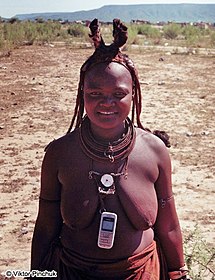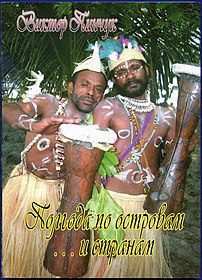Basics of fine-art photography/Creating works in ethnographic photo genre

Ethnographic photographing is the process of depicting indigenous peoples, based on visual distinctive features expressed in elements of clothing, jewelry, and anatomical features of those being photographed.
General information
[edit | edit source]This direction of photography is documentary in nature. Ethnographic photography can serve both academic and social purposes: the genre is one of the auxiliary ways of gaining knowledge in ethnology; but in the life of a society not associated with science, also finds application. As an example, the images of aborigines in popular geographic magazines. Summarizing what has been said, we conclude: ethnographic photography is related to both scientific and travel photography.
Peculiarities of the genre and ways of realization
[edit | edit source]First of all, for the working in this genre, the visual qualities of the subject are important. An aboriginals who has moved to a big city, retaining his ethnicity but losing his visual appeal, is of no interest to the photographer. Conversely, for example, the Ethiopian Mursi people, whose women wear a ceramic saucer cut into their lower lip from childhood, are paramount.
Having experience in creating works of the ethnographic genre, I woud like note that natives living in hard-to-reach places of the globe, one way or another, occasionally see foreigners who managed to get to them, and they know that Caucasian race people come, for the most part, for the purpose of taking pictures "savages", therefore, be prepared for the fact that you will be asked for some payment for the opportunity to capture picturesque-looking inhabitants of godforsaken places on the planet. The amount, usualy, is not very large and discussed downward, however, after an agreement, aboriginal becomes in the “hands at the seams” position, which in his point of view should be done while posing in front of the cameral. You can use a telephoto lens, or zoom, catching a vital moment when the subject is in action. But for this you need to ideally quickly handle the camera, practicing dexterity in advance. If successful, your final work will intersect with genre photography, which will give it additional qualities, if not, you will get a standard ethnographic shot.
The theme of penetrating into places on the planet where the inhabitants of the virgin jungle have never seen a civilized person is not considered, because it requires large expenses and is not compatible with the basic principles of hobo tourism.
Gallery
[edit | edit source]-
Himba (Namibia)
Photo taken on a Third creative trip to Africa -
Ni-Vanuatu (Pentecost Island)
Photo taken on the Expedition to Oceania -
Samburu (Kenia)
Photo taken on a Second creative trip to Africa
-
Mongol on the cover of book
Mongolian huyvaldagch -
Himba on the cover of book
Third African trip -
Papuans on the cover of book
Six months by islands... and countries -
Pashtun on the cover of book
Afghan prisoner -
Ni-Vanuatu on the cover of book
Two months of wandering and 14 days behind bars










